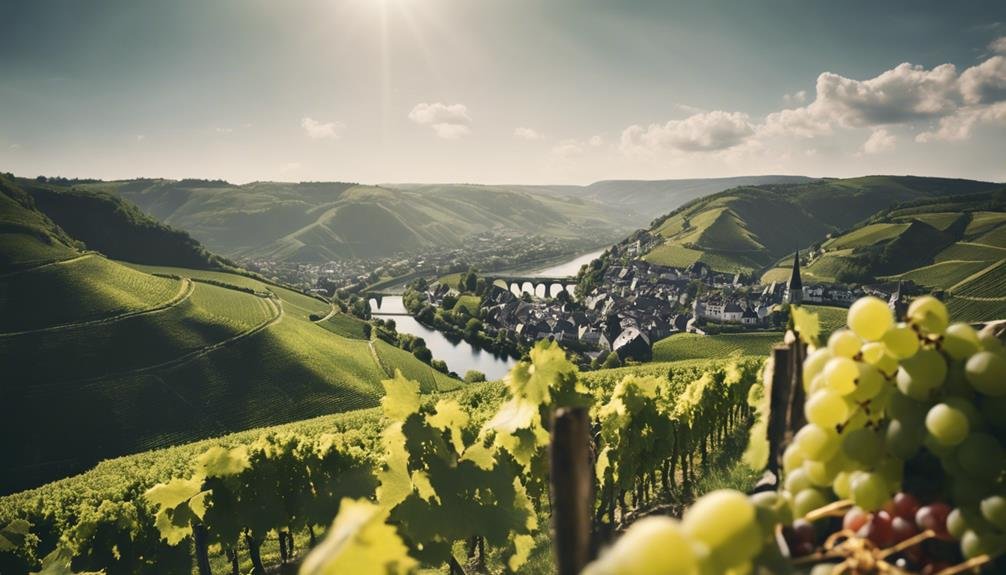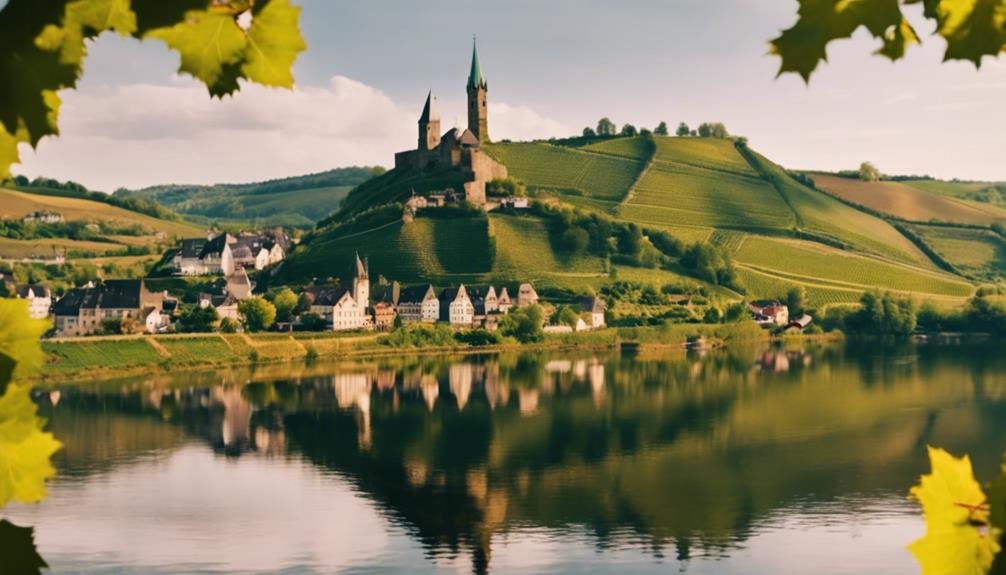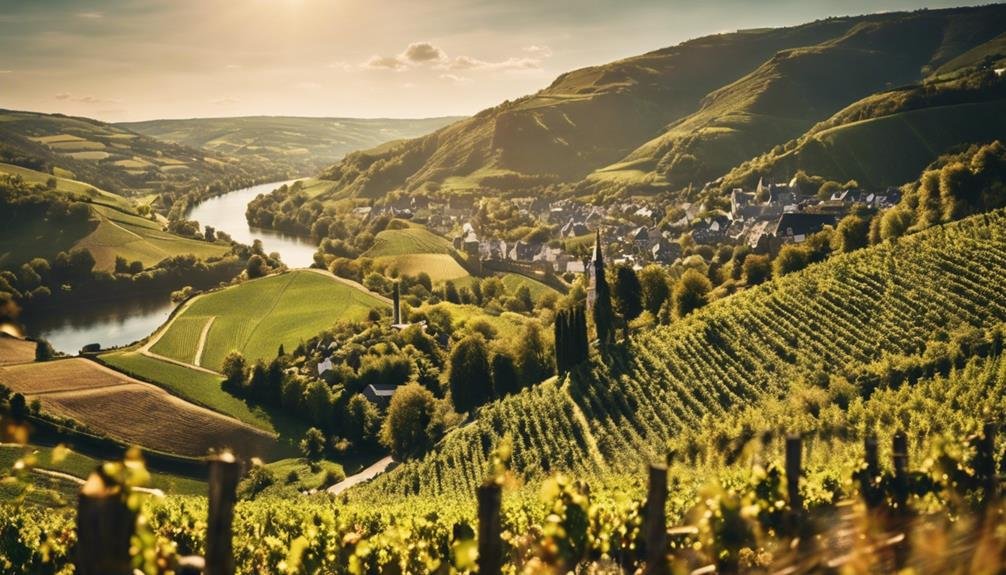Discover the charm of Mosel Valley wines with its flagship Riesling grape known for its versatility. From bone-dry to lusciously sweet, Mosel Rieslings captivate with high acidity and intricate flavors, offering remarkable aging potential. Delving deeper, assess quality based on pivotal factors like vintage and cellar storage. Explore six unique sub-regions that influence the terroir, showcasing steep slopes that elevate wine quality. Taste the impact of blue and red slate soils that contribute distinct minerality, with label details guiding you to esteemed vineyards. Explore the fascinating blend of historical geology, tourism allure, and export trends shaping this enchanting winemaking region.
Grape Varieties and Wine Portfolio
Certainly, the dominance of Riesling, encompassing over 60% of the vineyard land in the Mosel Valley, lays the foundation for its diverse and alluring wine portfolio.
Mosel Riesling wines, ranging from bone-dry to sweet, offer exceptional food pairings such as spicy dishes, seafood, and Asian cuisine, enhancing the dining experience.
Known for its high acidity and complex flavors, Mosel Rieslings have remarkable aging potential, developing honeyed notes, petrol aromas, and increased complexity over time.
Whether enjoyed young for their vibrant fruitiness or cellared for years to reveal their full potential, these wines showcase the region's unique terroir and winemaking expertise, making them a versatile choice for both immediate enjoyment and long-term aging.
Wine Classification and Vintage Selection
In understanding the world of Mosel Valley wines, delving into the intricacies of wine classification and vintage selection provides a thorough insight into the quality and characteristics of these renowned German wines.
- Quality assessment plays a pivotal role in determining the value and taste profile of Mosel wines.
- Cellar storage conditions are essential for preserving the delicate flavors and aromas of these wines over time.
- Selecting wines based on great vintages like 2015 guarantees exceptional quality, while understanding vintage ratings aids in making informed purchasing decisions. Vintage variation is key in identifying the finest offerings, guiding consumers towards memorable tasting experiences.
Geography, Climate, and Sub-Regions

Exploring the geographical features, climatic influences, and sub-regions of the Mosel Valley contributes greatly to understanding the diverse expressions found in its renowned wines.
The south-facing Mosel Valley boasts six distinct sub-regions, each offering unique Riesling expressions. Vineyards positioned to the south receive increased sunlight, while those on sloped vineyards benefit from greater sun exposure.
Approximately 40% of Mosel vineyards are situated on steep slopes, a factor that has a profound impact on wine quality. Knowledge of these sub-regions is essential for identifying the best vineyards producing high-quality wines.
As global warming continues to affect climates worldwide, the future may see shifts in preferred vineyard locations within the Mosel Valley, emphasizing the importance of understanding these geographic and climatic nuances for wine enthusiasts.
Soil, Geology, and Label Information
The unique character and quality of Mosel Valley wines are intricately tied to the region's distinctive soil composition, geological formations, and detailed label information.
- Blue and red slate soils impart a distinct slate minerality to Mosel wines, enhancing their flavor profiles.
- Red slate areas specifically produce a richer style of Riesling, adding depth and complexity to the wine.
- Label information on Mosel wines typically includes details such as the producer, village name, and vineyard names, aiding consumers in understanding the wine's origin and quality.
Vineyard mapping is a valuable tool for enthusiasts to locate specific vineyards and explore the diverse expressions of Riesling across different sub-regions in the Mosel Valley.
Historical Geology, Tourism, and Export Trends

Exploring the historical geology of the Mosel Valley reveals a fascinating story of the region's ancient beginnings, influencing its distinctive terroir for crafting outstanding wines. Dating back to the Devonian period, the slate soils of the Mosel area speak of its past as an ocean.
Presently, the Mosel Valley attracts wine enthusiasts worldwide through its thriving wine tourism. Despite its allure, only one-third of Mosel wine is exported, showcasing the region's focus on local consumption.
Known for its stunning beauty and unique wine experience, the Mosel Valley continues to captivate visitors with its picturesque vineyards and exceptional wine offerings. For those interested in delving deeper into the region's history and wine culture, abundant resources are readily available to satisfy their curiosity.
Frequently Asked Questions
What Food Pairings Best Complement Mosel Riesling Wines?
When pondering food pairings for Mosel Riesling wines, it's crucial to concentrate on their versatile flavor profiles. These wines, ranging from bone-dry to sweet, beautifully complement a wide array of dishes, from spicy Asian cuisine to delicate seafood fare.
How Do Winemakers in Mosel Valley Handle Climate Change Challenges?
Winemakers in Mosel Valley navigate climate change challenges through adaptation strategies and sustainability measures. These include adjusting vineyard practices, embracing new technologies, and cultivating heat-resistant grape varieties. Sustainability initiatives promote long-term viability amidst evolving environmental conditions.
Are There Any Unique Winemaking Traditions Specific to Mosel Valley?
Traditional winemaking techniques in Mosel Valley are deeply rooted in its winemaking history. Unique to the region is the use of steep slate vineyards, handpicking grapes, and gentle pressing methods, all contributing to the distinctive quality of Mosel wines.
What Sustainable Practices Are Adopted in Mosel Vineyards?
What sustainable practices are adopted in Mosel vineyards? Are organic farming and eco-friendly initiatives prioritized? Mosel vineyards embrace green practices like organic cultivation and sustainable viticulture, preserving the region's terroir while producing high-quality wines for future generations to enjoy.
How Do Mosel Wineries Balance Tradition With Modern Technology?
In the Mosel Valley, wineries balance tradition with modern technology by blending traditional techniques with modern innovations to optimize quality while maintaining efficiency. This delicate harmony marries old and new methods for crafting exceptional wines.
Conclusion
To sum up, the wines of Mosel Valley are like a finely woven tapestry, each bottle a masterpiece crafted with precision and tradition.
Just as a skilled artist blends colors and textures to create a work of art, winemakers in this region blend grape varieties, terroir, and expertise to produce enchanting wines that tell a story of craftsmanship and heritage.
The Mosel Valley wines are truly a masterpiece of winemaking.
